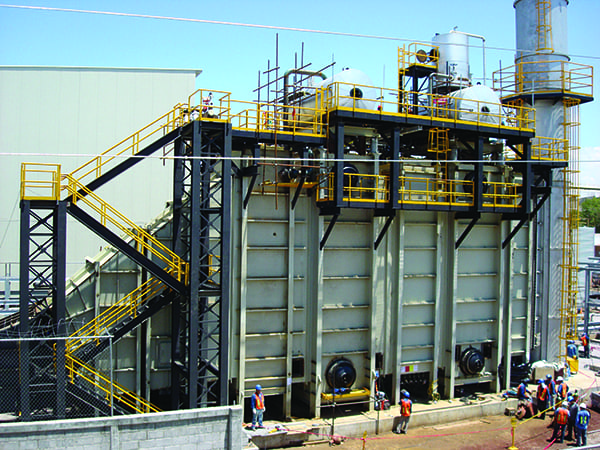Analytical Tool Helps HRSG Operators Compare Equipment Reliability
Credit to Author: POWER| Date: Mon, 01 Apr 2019 00:00:00 +0000
Ever since deregulation came to the power industry, combined cycle plant managers have been trying to benchmark their production metrics and cycling costs against those of their competitors.
There has always been an obstacle—which plants should they benchmark themselves against? Many plant-specific variables affect production metrics, such as type of fuel, make and model of gas turbine, and size and age of the plant. And there’s been a second obstacle—how are plant operators supposed to get production metrics from other plants when most power producers treat this data as confidential?
A Novel Benchmarking Database
Both of these benchmarking obstacles have been eased thanks to a new database that covers the U.S. fleet of combined cycle plants. The Innovative Total Quality Assurance Solution for the Grid (INGRID) has been published by Intertek Group PLC, an engineering and consulting company that’s been serving the combined cycle sector for decades. INGRID grew out of a nationwide study of cycling costs that the consulting company was commissioned to perform for the North American Electric Reliability Corp. (NERC).
The NERC study gathered data from 612 units with a total capacity of 102 GW. The data was combined with failure-analysis data from operations and maintenance (O&M) problems that Intertek had solved previously at combined cycle plants. That combination produced a robust analytical tool with the NERC/GADS (Generating Availability Data System) production metrics of equivalent forced outage factor, equivalent availability factor, and so on.
 |
1. This example of a modular heat recovery steam generator (HRSG) is among those for which the INGRID database can identify equipment failure rates. The database also can predict remaining service life of combined cycle equipment. Courtesy: Sphudson at English Wikipedia |
INGRID also drills down from these total plant production metrics into the metrics for specific equipment within power plants—such as failure rates of each plant’s heat recovery steam generators (HRSGs, Figure 1). And for folks wanting more details on HRSG failure rates, INGRID drills down yet again, identifying the rates for each of the HRSG failure mechanisms, classified by year. That enables HRSG users to see the progress they should be making in the prevention of each failure mechanism, by make and model of HRSG, so that HRSG buyers can compare each manufacturer’s reliability history (Figure 2).
 |
2. Intertek Group’s Innovative Total Quality Assurance Solution for the Grid (INGRID) is a database and analytics platform that provides detailed operating indicators and benchmarks for fossil power generators. Courtesy: Intertek Group |
INGRID’s benchmarking data currently is used by more than 80 subscribers, including gas- and coal-fired boiler plants, and simple cycle and combined cycle gas turbine plants. INGRID contains public information about every single unit in the U.S. and can be accessed through Ingrid.Intertek.com.
Potential customers can search their own units and can see data from other units, if they subscribe. The contact page enables them to see a complete demonstration of the database to test drive before they subscribe.
In addition to revealing historical metrics, the INGRID database looks into the future and predicts remaining service life of combined cycle equipment. Remaining service life is a big issue for combined cycle plant managers. Some equipment in aging plants has reached the point where it would be more economical to replace or upgrade it, rather than keep pouring maintenance money into a worn-out hunk of metal.
A remaining-life assessment study can reveal whether equipment has reached the point at which it’s better to replace or upgrade it. This study is inherently complex, because the primary cause of failure in combined cycle equipment is the very complex failure mechanism called creep-fatigue interaction.
Creep is the tendency of a metal to plastically deform under the influence of stress, high temperature, and time. Solving for all those variables requires a mountain of calculations. But going the next step and solving for creep’s interaction with that other HRSG damage mechanism—fatigue—requires a Mount Everest of calculations!
Fortunately, software embedded in the INGRID database works through those calculations, and it can assess the creep-fatigue damage that has accumulated in a plant’s equipment. The INGRID software makes this assessment by using the complex creep-fatigue formula discovered only recently in metallurgical tests; plant-specific operating history entered by each HRSG user; and the latest in data-manipulation techniques, such as pattern-recognition algorithms, or machine learning.
Machine Learning Not the Same as Artificial Intelligence
Machine learning is a practical tool that’s been applied for years in the monitoring and diagnostics (M&D) of power plants. Consider the following real-life example from a combined cycle plant in the western U.S. The steam temperature downstream of this plant’s attemperator was trending toward a saturated-steam condition, indicating that the attemperator was on the verge of over-spraying, which can cause serious damage in downstream components. Fortunately, pattern-recognition ability in the plant’s M&D software detected the trend long before the alarm setpoint was reached. This early detection enabled the plant manager to schedule a maintenance outage and overhaul the attemperator before any overspray damage occurred.
In another example of machine learning, a cogeneration plant in the southeastern U.S. retrofitted thermocouples on individual HRSG tubes and began trending the temperature readings with pattern-recognition software. During one morning’s routine startup, the pattern-recognition software detected an incipient problem called condensate quench—an HRSG failure mechanism caused by condensed steam that doesn’t get fully drained, and then quench-cools, or thermally shocks, individual tubes. In this case, the pattern-recognition software alerted plant operators to manually open the drain valves before any tubes were damaged.
—Rob Swanekamp, PE is executive director of the HRSG User’s Group Inc.; Martin Gascón, PhD is a physicist and data scientist with Intertek Group; and Doug Hilleman, PE is a principal
engineer with Intertek Group.
The post Analytical Tool Helps HRSG Operators Compare Equipment Reliability appeared first on POWER Magazine.